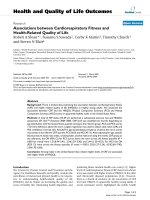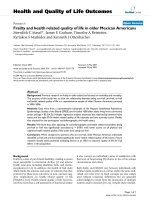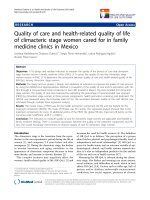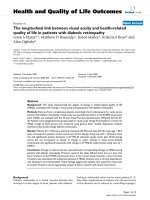Nutritional and health promoting attribute of kidney beans (Phaseolus vulgaris L.): A review
Bạn đang xem bản rút gọn của tài liệu. Xem và tải ngay bản đầy đủ của tài liệu tại đây (212.09 KB, 9 trang )
Int.J.Curr.Microbiol.App.Sci (2020) 9(5): 1201-1209
International Journal of Current Microbiology and Applied Sciences
ISSN: 2319-7706 Volume 9 Number 5 (2020)
Journal homepage:
Review Article
/>
Nutritional and Health Promoting Attribute of
Kidney Beans (Phaseolus vulgaris L.): A Review
S. Kimothi* and Y. S. Dhaliwal
Department of Food Science, Nutrition and Technology, CSK- Himachal Pradesh
Agricultural University, Palampur-176062, India
*Corresponding author
ABSTRACT
Keywords
Kidney beans,
diabetes, cancer,
dietary fiber,
degenerative
disease,
cardiovascular
disease
Article Info
Accepted:
10 April 2020
Available Online:
10 May 2020
Shifting towards plant based diet is good approach to tackle nutritional and
health issues. In this context, red kidney beans consider to be high in
component like protein carbohydrates, dietary fiber, minerals and vitamins.
Proteins are normally considered as the prominent macronutrient in red
kidney beans. Consumption of red kidney beans has been linked to
decreased occurrence of chronic non communicable diseases such diabetes,
cancer, obesity and coronary heart diseases. Similarly, red kidney beans
contain a variety of phyto-chemicals. These phyto-chemicals like,
flavonoids, polyphenols and antioxidants are conforming to offer protective
physiological effects in the body against numerous ailments i.e. cancer,
diabetics, cardiovascular diseases and neurodegenerative. Thus the present
aim of this review is to highlight the magnitude of the nutrition on such
ailments.
Introduction
Legumes are an important food source and
play a significant role in traditional diets all
over the world. Legumes are widely grown
and consumed in various regions, are
excellent sources of proteins, complex
carbohydrates and fairly good sources of
minerals, vitamins and polyunsaturated fatty
acids (Hudson, 1994). Legumes belongs to the
leguminaceae family are produced and
consumed widely throughout the world,
particularly in tropical and sub-tropical areas
of Africa, Asia and Latin America
(Barampama and Simard,1995).
The importance of legume seeds as food and
functional ingredients has stimulated much
attention to their utilization. They have been
used by food industries as ingredients and
1201
Int.J.Curr.Microbiol.App.Sci (2020) 9(5): 1201-1209
supplements in food products for many years.
For successful use in food applications, they
should
possess
several
desirable
characteristics, referred to as functional
properties (Hudson, 1994). Legumes occupy
an important place in human nutrition,
especially among the low-income groups of
populace in the developing countries.
Legumes are a good source of protein, which
is 2–3 times that of cereal grains, and are a
rich source of dietary fiber, starch minerals
and vitamins.
In addition, legumes belong to the food group
that elicits the lowest blood glucose response.
The general consensus on healthy eating
habits favors an increase in the proportion of
legume-based polymeric plant carbohydrates
including starch in the diet. The role of
legumes as a therapeutic agent in the diets of
persons suffering from metabolic disorders
has been reported previously (Shehata,
Darwish, Nahr & Razek, 1988; Simpson et
al., 1981).
Nutritional aspects
The various types of beans are a staple food
and a low-cost source of protein in many
countries where protein energy malnutrition is
prevalent widely. In recent years, KB has
been recognized as potential alternate source
of meat products and also as potent
antioxidant, with lower glycemic index useful
for persons suffering from diabetes, increased
satiation,
cardiovascular
diseases,
atherosclerosis and breast cancer (Beninger &
Hosfield, 2003; Cardador-Martinez, LoacraPina, & Oomah, 2002; Guajardo-Flores,
Serna-Saldívar, & Gutiérrez-Uribe, 2013;
Heimler, Vignolini, Dini, & Romani, 2005;
Madhujith, Naczk, & Shahidi, 2004; RochaGuzman et al., 2013; Xu, Yuan, & Chang,
2007).
The inclusion of legumes in the daily diet has
many beneficial physiological effects in
controlling and preventing various metabolic
diseases such as diabetes mellitus, coronary
heart disease and colon cancer (Tharanathan
& Mahadevamma, 2003). It has been reported
that the protective effects of dry beans in
disease prevention, such as against cancer,
may not be entirely associated to dietary fiber,
but to phenolics and other non-nutritive
compounds (Oomah, Tiger, Olson, &
Balasubramanian, 2006), as polyphenols from
dry beans may possibly act as antioxidants,
hindering the formation of free radicals
(Boateng, Verghese, Walker, & Ogutu, 2008).
Phaseolus is the most important food legume
for human consumption in the world. Its seeds
consist mainly of carbohydrates and are a
good source of nitrogen and protein. It also
contains calcium, magnesium, potassium,
phosphorus, copper, iron, zinc, manganese
and sulfur. This legume is rich in bioactive
components such as enzyme inhibitors,
lectins, phytates, oligosaccharides and
phenolics, which exhibit metabolic roles in
humans and animals. Among the observed
biological activities are the antioxidant
capacity, the reduction of cholesterol and
reduction of low-density lipoproteins, thus
Phaseolus has a protective effect against
cardiovascular diseases. Also it has shown
favorable effects against cancer because of
the anti-mutagenic and anti-proliferative
properties of their phenolics, lectins and
protease inhibitors. Additionally, it has
showed effects on obesity and diabetes due to
its content of resistant starch and α-amylase
inhibitor. Here we present a review of the
beneficial properties of beans as a
nutraceutical food.
Antioxidant profile
Antioxidants are the compounds that prevent
the human, animal and animal cells from
harmful effects of free radicals (Kukic et al.,
2006). Phenolic acids and flavonoids are the
1202
Int.J.Curr.Microbiol.App.Sci (2020) 9(5): 1201-1209
natural source of antioxidants which are
produced from plants. They are considerable
sources of antioxidants and more efficient
than Vitamin C, E and carotenoids (Dai and
Mumper,
2010).
The
antioxidant
characteristics of phenolic and flavonoid
compounds are driven from their capability to
regulate the antioxidant defense, scavenging
the radical species (Cotelle, 2001). The
reduction property of phenolic compounds
rely on the number of free hydroxyl groups
present in molecular structure (Ghasemzadeh
and Ghasemzadeh, 2011), whereas flavonoids
capability as antioxidants depends on position
of hydroxyl groups and some other features in
chemical structure (Saxena et al., 2012).
Kidney beans are a good source of the trace
mineral manganese which is an essential
cofactor in a number of enzymes important in
energy production and antioxidant defenses.
For example, the key oxidative enzyme
superoxide dismutase, which disarms free
radicals produced within the mitochondria
(the energy production factories within our
cells), requires manganese. (Bazzano 2003)
Amino acids profile
Red kidney beans show excellent amino acid
profile mainly rich in lysine, leucine, aspartic
acid,glutamic acid and arginine. Beans
provide optimum amount of essential amino
acids when utilized with cereals and other
sulfur containing products (Boye et al.,
2010a). The glutamic and aspartic acids are
mainly acidic in nature and present in raw as
well as processed beans. Except for cysteine,
methionine and tryptophan, the raw and
processed red kidney beans replenish the
FAO/WHO amino acid needs for teenagers.
Red kidney beans provide 10.2g glutamic
acid, 9.5g aspartic acid, 1.2g cysteine, 1.7g
methionine, 3g histidine, 4.4g alanine, 5.2g
glycine, 3.4g threonine, 3.3g proline, 3,7g
isoleucine, 3.1g tyrosine, 4.6g phenylalanine,
4.1g valine, 3.1g serine, 6.9g arginine,
7glysine and 7.2g leucine per 100g (Audu and
Aremu, 2011). Cowpea is methionine and
threonine rich legume. It also contains
glutamic acid & aspartic acid which are nonessential amino acids. Cowpea has essential
amino acids in higher quantity whilst lentil is
rich in non-essential amino acid (Iqbal et al.,
2006). Broad bean has methionine/cystine as
the limiting amino acids. However, mostly all
other EAAs fulfill the people needs though
the quantity in contrast to egg is lower
(Mortuza et al., 2009).
Dietary fiber
Dietary fiber can be classified as insoluble or
soluble (Zhang et al., 2011) and each class
have different physiological effects (Ajila and
Rao, 2013). The ratio between two classes of
dietary fiber is important for nutritional and
functional properties (Jaime et al., 2002). The
soluble dietary fiber faces bacterial
fermentation in the GIT and affects the
carbohydrates and fat metabolism. Whereas
insoluble fraction lower the incidence of
constipation by reducing the gastrointestinal
transit time and also hinder the development
of rectal cancer (Bingham et al., 2003).
Dietetic fiber can be defined as a
heterogeneous group of non-digestible
compounds, including fiber (soluble and
insoluble),
resistant
starch
and
oligosaccharides,
such
as
raffinose,
estachyose and mullein, among others. The
common bean (Phaseolus vulgaris L.) mostly
consumed in Latin America has a high fiber
content (Cruz-Bravo et al., 2011). Levels of
Cholesterol 7-α-hydroxylase on rats fed with
a pancreatin resistant fraction prepared from
kintoki beans (Phaseolus vulgaris) were
significantly higher compared to those of rats
on a cellulose diet. It also increased intestinal
content viscosity and decreased bile acid
absorption in the small intestine (Han et al.,
1203
Int.J.Curr.Microbiol.App.Sci (2020) 9(5): 1201-1209
2004). It has been shown that long-term
feeding with beans decreases cholesterol and
low-density lipoprotein (LDL) serum levels in
humans, so it seems likely that it can offer
protection against cardiovascular diseases
(Marzolo et al., 1993). The fibre isolated from
Phaseolus mungo showed a neutral detergent
residue (NDR). It has significant cholesterol
lowering activity and increased bile acid
excretion in faeces (Thomas, Leelamma, &
Kurup, 1983).
Gluten-free
People with celiac disease should consume a
diet that is free of gluten, a protein found in
many grain products. They must eliminate
these products from their diet, which
increases the risk for deficiencies in several
B-vitamins and other nutrients that typically
are found in grains (Niewinski et al., 2008).
Beans are a naturally gluten-free food, and
they provide many of the same vitamins and
minerals often found in enriched grain
products, including thiamin, riboflavin, folate,
iron and fiber. Bean flour may be particularly
beneficial to those following gluten-free diets
because bean flours can be combined with
other gluten-free flours (such as rice or
tapioca flour).
Health benefits of kidney beans
Kidney beans and cancer
Cancer is referred to as a multi-step disease.
Factors such as environmental, physical,
chemical, metabolic and genetic factors have
a direct or indirect role in the development of
cancer (Fimognari et al., 2005). Cancer is
attributed to independent DNA replication
and cellular division of abnormal cells which
leads to induction of cancerous tumors and
causes the destruction of adjacent tissue or
lymphatic system. It has been reported that
phenolic acids present in red kidney beans
have anticancer characteristic (Nyau, 2014;
Duranti, 2006). They can act as an inhibiting
agent and hinder the development of tumors
from initiated stages. They can also suppress
cell multiplication in vitro (Scalbert et al.,
2005).
Epidemiological and preclinical studies
evaluating colon and prostate cancer have
provided additional evidence about an inverse
relationship between bean consumption and
cancer development (Monroe et al., 2003;
Thompson et al., 2012). Colorectal cancer is
the second principal cause of death related to
cancer in developed countries. Studies for its
detection have not diminished the incidence
or the mortality of this disease, so the interest
has focused on preventive strategies focused
on life style interventions (Derry, Raina,
Agarwal, & Agarwal, 2013). Epidemiological
evidence suggests a protective effect of
dietary fibre against colorectal cancer. It has
been reported that rats with induced colon
cancer and fed with pinto, black and white
beans developed four times fewer tumours
compared to rats not fed with beans
(Reynoso-Camacho et al., 2007).
Kidney beans and diabetes mellitus
The regulation of blood glucose level is the
main objective in diabetes management. The
glycaemic control has a great importance in
management of type 2 diabetes. The soluble
fiber fraction can control the glycemic by
slowing down and decreasing the absorption
of glucose from intestine (Brown et al.,
1999). Several studies related to diabetics
have shown that diets contain higher fiber
contents and low GI rating lead to better
glycated proteins levels which are helpful in
controlling the glycaemic index (Kendall et
al., 2006). They can reduce the incidence of
diabetes type 2 (Eshak et al., 2010) by
lowering the digestion and absorption of
macronutrients and reducing the contact time
1204
Int.J.Curr.Microbiol.App.Sci (2020) 9(5): 1201-1209
between intestinal lumen and carcinogens
(Raninen et al., 2011). The water soluble
fibers enter in small intestine where they
thicken the content of small intestine and
modulate the digestive process by reducing
the nutrients diffusion for absorption and
interaction time of food and digestive
enzymes.
Hyperglycemia in type 2 diabetes mellitus
(DM2)
correlates
with
endothelial
dysfunction and an increase in the intimamedia thickness, as well as with a greater
prevalence of atherosclerotic plaques. This is
related to an increase in oxidative stress with
platelet activation, thrombin production and
low-density lipoprotein oxidation which
increase the risk of cardiovascular diseases
related to DM2 (Barrett and Udani, 2011).
The oral administration of a Phaseolus
vulgaris ethanolic extract (200 mg/kg of body
weight) for 45 days to streptozotocin-induced
diabetic
rats
significantly
decreased
tiobarbituric acid and hydroperoxide reactive
substances. The extract caused a significant
increase in reduced glutathione, superoxide
dismutase, catalase, glutathione peroxidase,
and glutathione-S-transferase in the liver and
kidneys. The extract was more effective than
glibenclamide in diminishing glucose levels
(Venkateswaran and Pari, 2002).
Starch in beans is slowly digested and
attenuates postprandial response to insulin
(Feregrino-Pérez et al., 2008; Hangen and
Bennink, 2002). The α-amylase inhibitor
isoform 1 (α-AI1) has been extracted and
used in diverse commercial products against
obesity and diabetes in humans (Barrett and
Udani, 2011; Celleno, Tolaini, D’Amore,
Perricone, and Preuss, 2007; Obiro, Zhang,
and Jiang, 2008). Epidemiological studies
have linked bean consumption with a lowered
risk of being overweight or obese. In US
adults, bean consumers presented 23% lower
risk of obesity, and lower systolic blood
pressure. Studies of Brazilian adults indicate
that a regular diet including beans correlates
with a lower risk of being overweight and
obese, both in men (−13%) and women
(−14%) (Nilsson, Johansson, Ekström and
Björck, 2013). In addition, there is evidence
that a bean extract used by humans lowers
body weight, percentage of fat and waist and
hip circumference (Preuss, 2009).
Kidney beans and cardiovascular disease
Maintaining healthy blood pressure levels
promotes heart health and reduces risk of
cardiovascular disease and stroke. The
D.A.S.H. (Dietary Approaches to Stop
Hypertension) study found that a diet lower in
sodium and rich in fruits, vegetables,
legumes, fat-free and low-fat dairy, whole
grains foods, fish, poultry, seeds, and unsalted
nuts reduced blood pressure compared to the
control diet, which was modeled after the
typical American diet. (Moore et al., 1999)
Many of the food groups included in the
D.A.S.H. eating plan are natural sources of
potassium, including beans.
Bazzano et al., (2001) reported that
individuals consuming legumes at least four
times per week had a 22% lower risk of heart
disease than individuals consuming legumes
less than once per week. In the
epidemiological studies where legumes are
consumed as part of a healthier diet plan,
consistent reductions in heart disease risk
have also been observed. In the Health
Professionals Follow-up Study, men who
adhered to a more “prudent” diet that included
greater consumption of whole grains,
legumes, fish, and poultry had a 30% lower
risk of heart disease. Conversely, individuals
following
a
more
“Western”
diet,
characterized by increased consumption of
red meat, refined grains, sweets, French fries,
and high fat desserts had a higher risk of heart
disease. (Hu, 2000) Similar trends were seen
in the Nurses’ Health Study. Those who
1205
Int.J.Curr.Microbiol.App.Sci (2020) 9(5): 1201-1209
consistently ate the “prudent” diet had half the
risk of developing heart disease compared to
those that most often ate the “Western” diet.
(Fung, 2001) Epidemiologic studies support
the cardio protective effects of legumes as
part of a healthy diet. In particular, one study
examined the relationship between bean
consumption
and
occurrence
of
cardiovascular disease (CVD) and reported
that one serving (1/2 cup) per day of beans
was associated with a 38% lower risk of
myocardial infarction (Kabagambe, 2005). A
second study reported that individuals
consuming legumes at least four times per
week had a 22% lower risk of heart disease
than individuals consuming legumes less than
once per week. (Bazzano, 2001)
Kidney beans and degenerative diseases
Polyphenols are plant metabolites with potent
anti-oxidant properties, which help to reduce
the effects of oxidative stress-induced dreaded
diseases. The evidence demonstrated that
dietary polyphenols are of emerging
increasing scientific interest due to their role
in the prevention of degenerative diseases in
humans. Possible health beneficial effects of
polyphenols are based on the human
consumption and their bioavailability.
Common beans (Phaseolus vulgaris L.) are a
greater source of polyphenolic compounds
with numerous health promoting properties.
Polyphenol-rich dry common beans have
potential effects on human health, and possess
anti-oxidant, anti-diabetic, anti-obesity, antiinflammatory and anti-mutagenic and anticarcinogenic properties. Based on the studies,
the current comprehensive review aims to
provide up-to-date information on the
nutritional
compositions
and
healthpromoting effect of polyphenol-rich common
beans, which help to explore their therapeutic
values for future clinical studies (Kumar
Ganesan and Baojun Xu 2017).
Kidney beans and heart health
Kidney beans are a very good source of
cholesterol-lowering fiber, as are most other
beans. In addition to lowering cholesterol,
kidney beans' high fiber content prevents
blood sugar levels from rising too rapidly
after a meal, making these beans an especially
good choice for individuals with diabetes,
insulin resistance or hypoglycemia. When
combined with whole grains such as rice,
kidney beans provide virtually fat-free high
quality protein.
But this is far from all kidney beans have to
offer. Kidney beans are an excellent source of
the trace mineral, molybdenum, an integral
component of the enzyme sulfite oxidase,
which is responsible for detoxifying sulfites.
Sulfites are a type of preservative commonly
added to prepared foods like delicatessen
salads and salad bars.
Persons who are sensitive to sulfites in these
foods may experience rapid heartbeat,
headache or disorientation if sulfites are
unwittingly consumed. If you have ever
reacted to sulfites, it may be because your
molybdenum stores are insufficient to
detoxify them (Bazzano et al., 2003).
Modern life-styles induce people to change
eating habits by increasing high caloric
density food intake. High glycemic index and
high fat foods, mainly from processed and
simple sugar derived products, increase risks
of chronic diseases. Intake of pulses,
particularly beans, has been diminishing
during the last few years. Scientific evidence
shows that this vegetal food group is not only
important due its nutritional contribution, but
also because its consumption is related to a
lower risk of developing important chronic
non-transmissible diseases. Phaseolus has
several beneficial biological activities in
humans, as an antioxidant source, cholesterol-
1206
Int.J.Curr.Microbiol.App.Sci (2020) 9(5): 1201-1209
and
low-density
lipoprotein-lowering
properties, anti-mutagenic and anticancer
effects as well as effects on cardiovascular
disease, diabetes and obesity. It is important
to make efforts to increase consumption of
beans and take advantage of the benefits.
On the other hand, beans could be a good
source of nutraceuticals for human
supplementation, mainly compounds that
disappear with cooking conditions but exhibit
important biological activity.
References
Ajila, C.M. and Rao, U.J.S.P. (2013). Mango peel
dietary fiber: Composition and associated
bound Phenolics. J. Funct. Foods 5, 444450.
Audu, S.S. and Aremu, M.O. (2011). Effect of
Processing on Chemical Composition
ofRed Kidney Bean (Phaseolus vulgaris
L.) Flour. Pak. J. Nutr. 10,1069-1075.
Barampama, S and Simard, R.E. (1995). Effect of
soaking, cooking and fermentation on
composition, in vitro starch digestibility
and nutritive value of common beans.
Plant Foods for Human Nutrition 40,
349-365.
Bazzano L.A., He J., Ogden L.G., Loria C.M., and
Whelton P.K. (2003). Dietary fiber intake
and reduced risk of coronary heart disease
in US men and women: the National
Health and Nutrition Examination Survey
I Epidemiologic Follow-up Study. Arch
Intern Med. 163(16), 1897-904.
Bazzano, L.A, He, J., Ogden, L.G. (2001).
Legume consumption and risk of
coronary heart disease in US men and
women. Arch Intern Med 161(21), 25732578.
Beninger, C.W., and Hosfield, G.L. (2003).
Antioxidant activity extracts, condensed
tannin fractions, and pure flavonoids from
Phaseolus vulgaris L. seed coat color
genotypes. Journal of Agricultural and
Food Chemistry 51, 7879–7883.
Bingham, S.A., Day, N.E., Luben, R., Ferrari, P.,
Slimani, N., Norat, T., Clavel-Chapelon,
F., Kesse, E., Nieters, A., Boeing, H.,
Tjonneland, A., Overvad, K., Martinez,
C., Dorronsoro, M., Gonzalez, C.A., Key,
T.J., Trichopoulou, A., Naska, A., Vineis,
P., Tumino, R., Krogh, V., Bueno-deMesquita, H.B., Peeters, P.H., Berglund,
G., Hallmans, G., Lund, E., Skeie, G.,
Kaaks, R., and Riboli, E. (2003). Dietary
fiber in food and protection against
colorectal cancer in the European
Prospective Investigation into Cancer and
Nutrition (EPIC): an observational study.
Lancet. 361, 1496-1501.
Boateng, J., Verghese, M., Walker, L.T., &
Ogutu, S. (2008). Effect of processing on
antioxidant content in selected dry beans
(Phaseolus spp. L.). LWT – Food Science
and Technology 41, 1541–1547.
Boye, J.I., Zare, F. and Pletch, A. (2010a). Pulse
proteins: processing, characterization,
functional properties and applications in
food and feed. Food Res. Int. 43, 414431.
Brown, L., Rosner, B., Willett, W.W. and Sacks,
F.M. (1999). Cholesterol-lowering effects
of dietary fiber: a meta-analysis. Amer. J.
Clin. Nutr. 69, 30-42.
Cardador-Martinez, A., Loacra-Pina, G., and
Oomah, B.D. (2002). Antioxidant activity
in common beans (Phaseolus vulgaris L.).
Journal of Agricultural and Food
Chemistry 50, 6975–6980.
Chung H., Liu Q., Peter P., Ming Z. and Rickey
Y. (2008). In vitro starch digestibility,
expected glycemic index and some
physicochemical properties of starch and
flour from common bean (Phaseolus
vulgaris L.) varieties grown in Canada.
Food Research International 11(2) 316321.
Cotelle, N. (2001). Role of flavonoids in oxidative
stress. Curr. Topics Med. Chem. 1, 569590.
Dai, J. and Mumper, R. (2010). Plant phenolics:
extraction, analysis and their antioxidant
and anticancer properties. Mole 15, 73137352.
Derry, M.M., Raina, K., Agarwal, C., and
Agarwal, R. (2013). Identifying molecular
targets of lifestyle modifications in colon
cancer prevention. Frontiers in Oncology
1207
Int.J.Curr.Microbiol.App.Sci (2020) 9(5): 1201-1209
3, 119.
Duranti, M. (2006). Grain legume proteins and
nutraceutical properties. Fitoterapia, 77,
67-82.
Eshak, E.S., Iso, H., Date, C., Kikuchi, S.,
Watanabe, Y., Wada, Y., Kenji, W. and
Akiko, T. (2010). Dietary fiber intake is
associated with reduced risk of mortality
from cardiovascular disease among
Japanese men and women. J. Nutr. 140,
1445-1453.
Fung, T.T., Willett, W.C., Stampfer, M.J.,
Manson, J.E., and Hu, F.B. (2001).
Dietary patterns and the risk of coronary
heart disease in women. Archives of
Internal Medicine. 161(15), 1857-1862.
Ghasemzadeh, A. and Ghasemzadeh, N. (2011).
Flavonoids and phenolic acids: Role and
biochemical activity in plants and human.
J. Med. Plants Res. 5, 6697-6703.
Guajardo-Flores, Daniel, Serna-Saldívar, Sergio
O., and Gutiérrez-Uribe, Janet A. (2013).
Evaluation of the antioxidant and
antiproliferative activities of extracted
saponins and flavonols from germinated
black beans (Phaseolus vulgaris L.). Food
Chemistry 141(2), 1497–1503.
Heimler, D., Vignolini, P., Dini, M.G., and
Romani, A. (2005). Rapid tests to assess
the antioxidant activity of Phaseolus
vulgaris L. dry beans. Journal of
Agricultural and Food Chemistry 53,
3053–3056.
Hu, F.B., Rimm, E.B., Stampfer, M.J., Ascherio,
A., Spiegelman, D., and Willett, W.C.
(2000). Prospective study of major dietary
patterns and risk of coronary heart disease
in men. American Journal of Clinical
Nutrition 72(4), 912- 921.
Hudson, B.J.F. (1994). New and Developing
source of food proteins. Chapman & Hall.
London.
Iqbal, A., Iqtidar, A., Khalil, N., Ateeq and Khan,
M. S. (2006). Nutritional quality of
important food legumes. Food Chem. 97,
331-335.
Kabagambe, E.K., Baylin, A., Ruiz-Narvarez, E.,
Siles, X., and Campos, H. (2005).
Decreased consumption of dried mature
beans is positively associated with
urbanization
and
nonfatal
acute
myocardial infarction. J Nutr. 135(7),
1770-1775.
Kukic, J., Petrovic, S. and Niketic, M. (2006).
Antioxidant activity of four endemic
Stachys taxa. Biol. Pharmaceut. Bull. 29,
725-729.
Kumar, G., and Baojun, Xu. (2017). PolyphenolRich Dry Common Beans (Phaseolus
vulgaris L.) and Their Health Benefits Int
J Mol Sci. 18(11), 2331.
Kutos, T., Golob, T., Kac, M., and Plestenjak, A.
(2002). Dietary fiber of dry processed
beans. Food Chemistry 80, 231–235.
Madhujith, T., Naczk, M., and Shahidi, F. (2004).
Antioxidant activity of common beans
(Phaseolus vulgaris L.). Journal of Food
Lipids 11, 220–233.
Monroe, K.R., Hankin, J.H., Pike, M.C.,
Henderson, B.E., Stram, D.O., Park, S.,
and Kolonel, L.N. (2003). Correlation of
dietary intake and colorectal cancer
incidence among Mexican-American
migrants: The multiethnic cohort study.
Nutrition and Cancer 45, 133–147.
Moore, T.J., Vollmer, W.M., Appel, L.J., Sacks,
F.M., Svetkey, L.P., Vogt, T.M., Conlin,
P.R., Simons-Morton, D.G., CarterEdwards, L., and Harsha, D.W. (1999).
Effect of dietary patterns on ambulatory
blood pressure: reulsts from the Dietary
Approachs to Stop Hypertention (DASH)
Trial: DASH Collaborative Research
Group. Hypertension. 34(3), 472-7.
Mortuza, M.G. and Tzen, J.T. (2009).
Physicochemical
and
functional
properties of tencultivars of seem (Lablab
purpureus L.), an underexploited bean in
Bangladesh. J. Sci. Food Agric. 89, 12771283.
Niewinski, M.M. (2008). Advances in celiac
disease and gluten-free diet. J Am Diet
Assoc. 108, 661-672.
Nyau, V. (2014). Nutraceutical perspective and
utilization of common beans (Phaseolus
vulgaris L): A review. Afr. J. Food Agri.
Nutr. Deve. 14, 9483-9493.
Oomah, B.D., Tiger, N., Olson, M., and
Balasubramanian, P. (2006). Phenolics
and antioxidative activities in narrowleafed lupins (Lupinus angustifolius L.).
Plant Foods for Human Nutrition 61, 91–
1208
Int.J.Curr.Microbiol.App.Sci (2020) 9(5): 1201-1209
97.
Osorio-Diaz P., Bello-Perez L., A. Sayago-Ayerdi
S., G. Benitez-Reyes M. D., Tovar J., and
Paredes-Lopez O. (2003). Effect of
processing and storage time on in vitro
digestibility and resistant starch content of
two bean (Phaseolus vulgaris) varieties.
Journal of Science of Food and
Agriculture 83, 1283–1288.
Raninen, K., Lappi, J., Mykkanen, H. and
Poutanen, K. (2011). Dietary fiber type
reflects
physiological
functionality:
comparison of grain fiber, inulin and
polydextrose. Nutr. Rev. 69, 9-21.
Reynoso-Camacho, R., Ríos-Ugalde, M.C.,
Torres-Pacheco, I., Acosta- Gallegos,
J.A., Palomino-Salinas, A.C., RamosGómez, M. and Guzmán-Maldonado,
S.H. (2007). Common bean (Phaseolus
vulgaris L.) consumptions and its effects
on colon cancer in spraguedawley rats.
Agricultura Técnica en México 33(1), 43–
52.
Rocha-Guzman, N.E., Gallegos-Infante, J.A.,
Gonzalez-Laredo,
R.F.,
CardozaCervantes, V., Reynoso-Camacho, R., and
Ramos-Gomez, M. (2013). Evaluation of
culinary quality and antioxidant capacity
forMexican common beans (Phaseolus
vulgaris L.) canned in pilot plant.
International Food Research Journal
20(3), 1087–1093.
Saxena, M., Saxena, J. and Pradhan, A. (2012).
Flavonoids and Phenolic Acids as
Antioxidants in Plants and Human Health.
Int. J. Pharmaceut. Sci. Rev. Res. 28, 130134.
Scalbert, A., Manach, C., Morand, C., Remesy, C.
and Jimenez, L. (2005). Dietary
polyphenols and the prevention of
diseases. Crit. Rev. Food Sci. Nutr. 45,
287-306.
Shehata, N.A., Darwish, N., Nahr, F.E., and
Razek, F. A. A. (1988). Supplementation
of wheat flour with some local legumes.
Die Nahrung 31, 3–8.
Simpson, H.C., Lousley, R.S., Greekie, M.,
Hockaday, T.D.R., Carter, R.D., and
Mann, J. I. (1981). A high carbohydrate
leguminous fibre diet improves all aspects
of diabetes control. Lancet 1, 1–4.
Tharanathan, R.N., and Mahadevamma, S. (2003).
Grain legumesda boon to human
nutrition– review. Trends in Food Science
and Technology 14, 507–518.
Thompson, M.D., Mensack, M.M., Jiang, W., Zhu,
Z., Lewis, M. R., McGinley, J. N., and
Thompson, H. J. (2012). Cell signaling
pathways associated with a reduction in
mammary cancer burden by dietary common
bean
(Phaseolus
vulgaris
L.).
Carcinogenesis 33, 226–232.
Van Heerden, S.M., and Schonfeldt, H.C. (2004).
The need for food composition tables for
Southern Africa. Journal of Food
Composition and Analysis 17, 531–537.
Xu, B.J., Yuan, S.H., and Chang, S.K.C. (2007).
Comparative studies on the antioxidant
activities of nine common food legumes
against copper-induced human lowdensity lipoprotein oxidation in vitro.
Journal of Food Science 72(7), S522–
S527.
Zhang, H.W., Yang, M.D., and Fan, X.F. (2011).
Study on modification of dietary fiber
from wheat bran. Adv. Mat. Res. 183,
1268-1272.
How to cite this article:
Kimothi. S and Dhaliwal. Y. S. 2020. Nutritional and Health Promoting Attribute of Kidney
Beans (Phaseolus vulgaris L.): A Review. Int.J.Curr.Microbiol.App.Sci. 9(05): 1201-1209.
doi: />
1209









